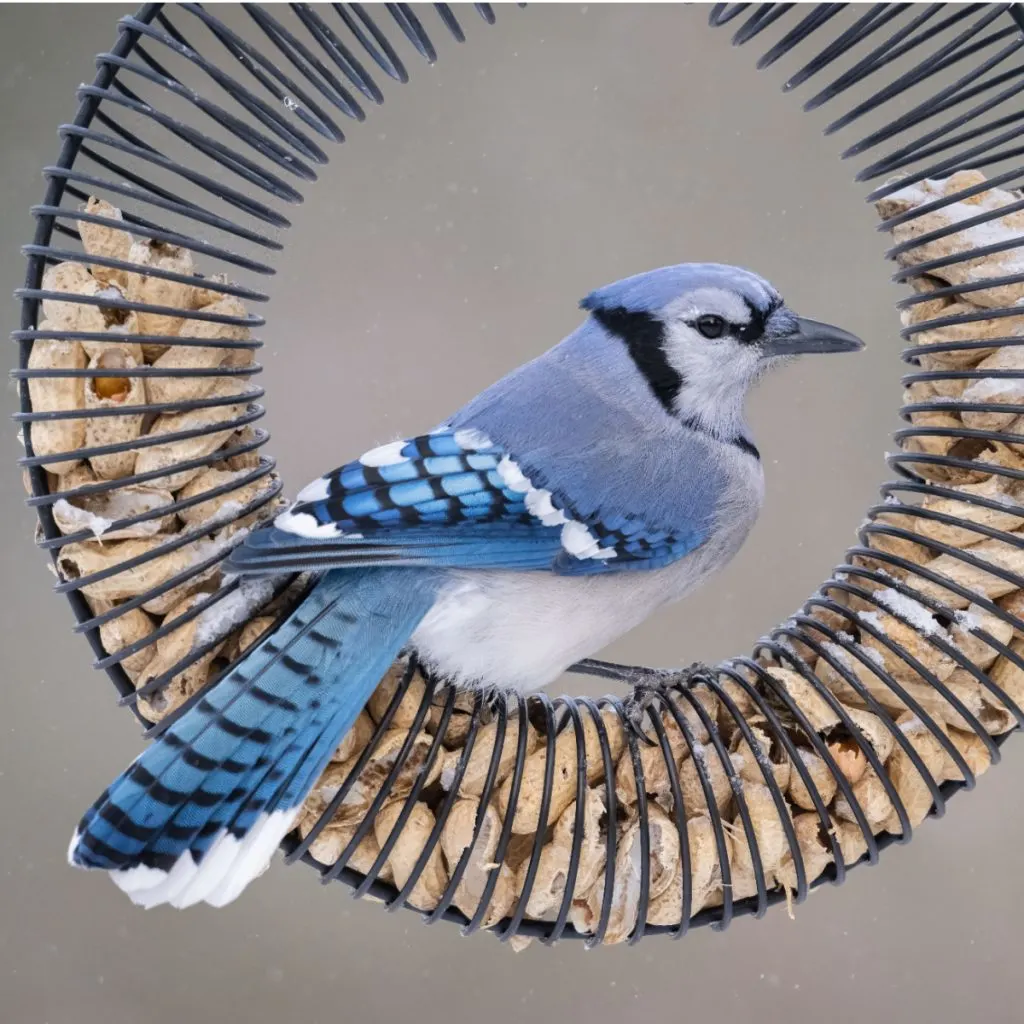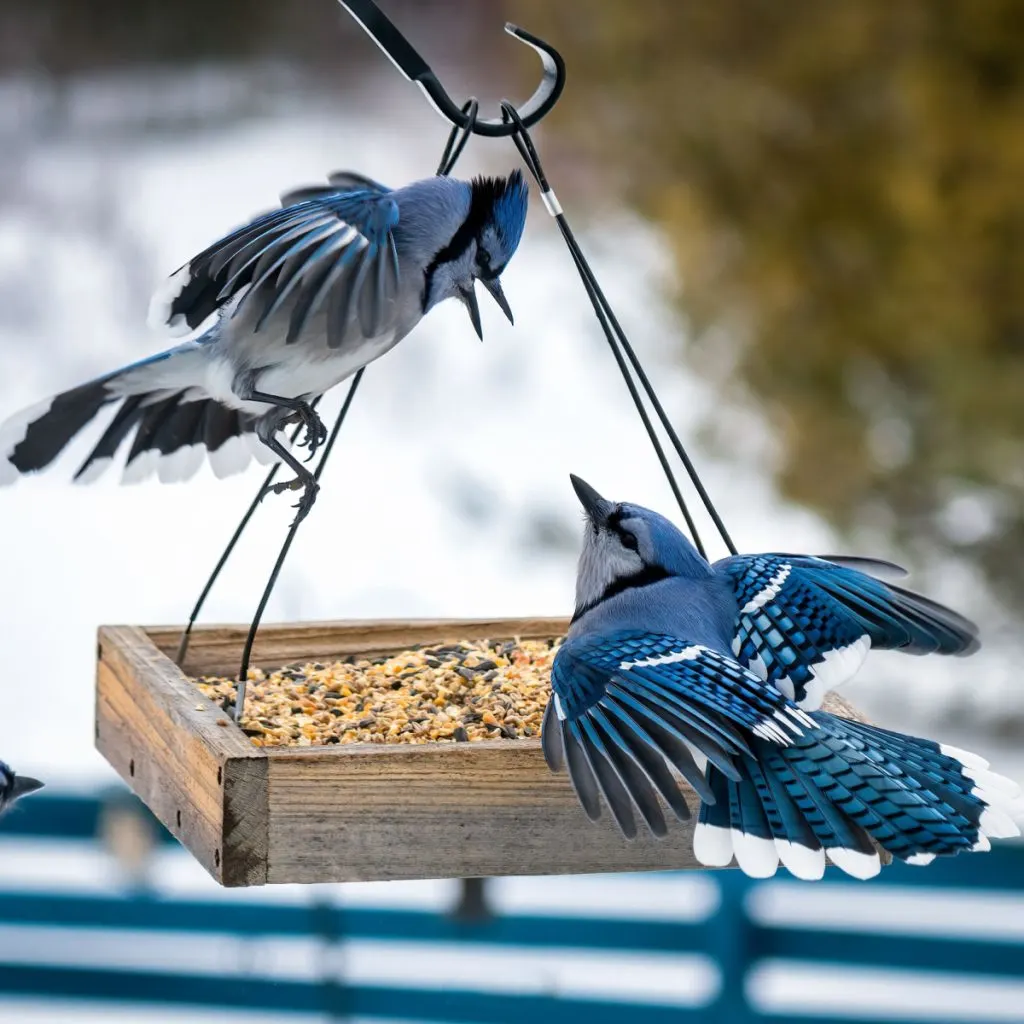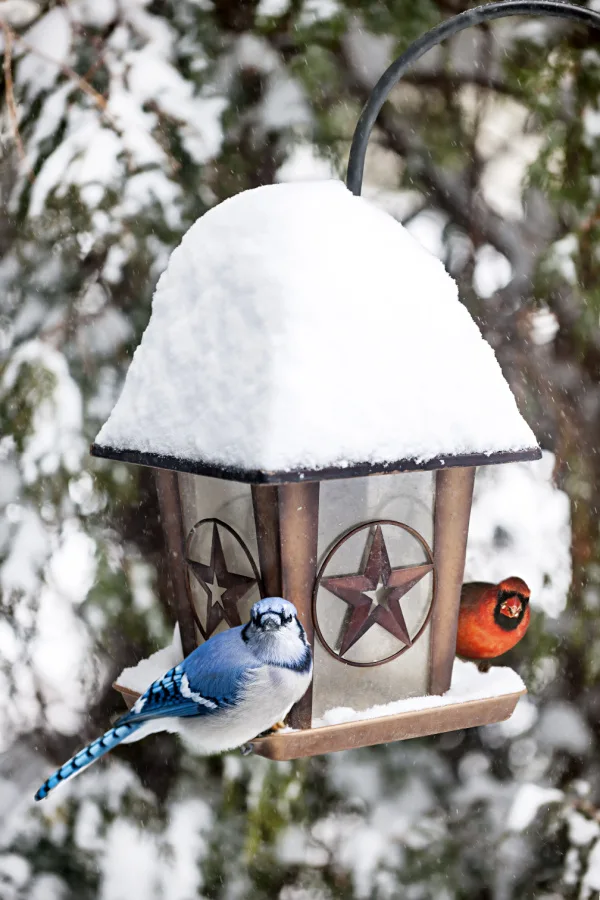Looking for a few tips and tricks for the best way to feed blue jays in the fall and winter – and still keep all of the other birds you love feeding around too?
Blue jays are some of the most beautiful birds to view in your backyard. Especially in the fall and winter as their bright blue feathers and white mid-section make them stand out. Besides their good looks, blue jays also happen to be quite smart and playful, often making loud calls and showing off their bold personalities.
However, they can also be a bit bossy at bird feeders. And they can also use some pretty amazing tactics to keep other birds away while they feed. One of the most incredible is that they are known to mimic the calls of hawks to trick other birds to stay away from feeders!

But in addition to being smart and bossy, they can also be a bit of a bully at times, often scaring away other smaller birds you might be trying to feed. Which leads to the question – can you really feed blue jays and still keep other birds around? Thankfully, the answer is yes. And it’s easier to do than you might think!
The Best Way To Feed Blue Jays In The Fall & Winter
Feeding blue jays while keeping smaller birds safe and happy is all about using the right setup and foods. Let’s first cover how to create a separate feeding area for blue jays and which feeders are the best for doing so. Then, we will take a look at what foods to fill them with to attract only blue jays.
It’s important to set up a different feeder in a space away from your regular feeders. The good news is that blue jays are incredibly adept at finding the new feeder and coming back to it regularly once they do.
The first key is to use strong feeders. Blue jays are bigger than most backyard birds and need feeders that are durable and big enough to hold them. Platform feeders or tray feeders work well because they have lots of space for blue jays to land on.
Make sure the feeder is made of strong materials like metal or thick plastic so it doesn’t break under their weight. In addition, keep feeders far enough away to be out of the sight line of your other feeders.

Feeding Blue Jays
Now its all about giving them the food they like. One of the best of all is peanuts. Blue jays love peanuts, whether they’re in the shell or out. Peanuts are full of protein and healthy fats, which are great for energy during the colder months.
You can put peanuts on a tray feeder, but one of the best ways to feed whole peanuts is with a peanut wreath feeder. Blue jays love them and other birds don’t – so it’s a great way to give them their own feeding space. Product Affiliate Link: Songbird Essentials Whole Peanut Black Wreath Feeder For Blue Jays
More Great Seeds & Feeds For Blue Jays – The Best Way To Feed Blue Jays In The Fall & Winter
Both black-oil and striped sunflower seeds are also blue jay favorites. They’re easy for jays to crack open and eat. Dried corn and cracked corn can be a good snack, but use it sparingly since it can attract other animals like squirrels.
In the winter months, suet can also provide much needed energy blue jays need to survive the frigid temperatures. For this, look for suet cakes with nuts or fruit as they give a lot of additional nutrition to jays. See our article: How To Make Homemade Bird Suet – Create Great Food For Birds!
Last but not least, blue jays enjoy mealworms too. These can be dried or live and make a nice treat to give them a big dose of energy.
Listen In To Our Podcast Below!

One final note on feeding blue jays, although they are happy to eat from a feeder, they also enjoy eating from the ground as well. In addition to filling trays or wreath feeders, also scatter feed on the ground near bushes or trees for them.
This helps spread out the feeding and makes it feel more natural for the birds. So now that we know what to feed blue jays – and to keep their feeder away from your other feeders – let’s now take a look at how to help feed and keep other birds safe and happy as well.
How To Keep Other Birds Happy & Safe From Blue Jays – The Best Way To Feed Blue Jays In The Fall & Winter
One of the best ways to keep smaller birds visiting your yard is by using caged feeders. These are feeders have a cage around them to keep out bigger birds like blue jays. They are perfect for small birds like chickadees, finches, and sparrows to eat without worry. Affiliate Link: Gray Bunny Wild Bird Cage Feeders
In addition to protective feeders, you can also feed smaller birds the foods that blue jays don’t prefer. For example, goldfinches love nyjer seeds, and many other small birds like chickadees enjoy safflower seeds, both of which blue jays simply don’t care for.

Extra Tips for Fall and Winter Bird Feeding
No matter if it’s blue jays, chickadees, cardinals or any other birds, when feeding in the winter, it’s important to keep your feeders clean for the health of the birds.
Sweep up shells and old food regularly so mold and bacteria can’t build up. It’s also important to make sure feeders are protected from rain and snow so the food doesn’t get moldy. Moldy food can easily make birds sick.
Use warm, soapy water to clean feeders often. Once a month, disinfect feeders with a bleach solution. For this, a one-tenth bleach to water ratio works best.
It’s also important in the fall and winter to feed consistently. Birds have a harder time finding food, and once they do find a source, they will rely on it. Keeping your feeders full helps them stay healthy during these colder months.
Birds also need water year-round. Use a heated birdbath to keep the water from freezing so the birds have access to it. Last but not least, avoid feeding birds salty snacks like chips or salted nuts, as these can be harmful to them.
Here is to finding a way to feed blue jays this fall and winter – without driving away all of the other birds you love to feed as well!
Simple Garden Life
Follow Our Facebook Page For Even More Great Tips! Simple Garden Life Facebook Page
Simple Garden Life is a website dedicated to keeping gardening fun, simple and enjoyable! We publish two new articles each week along with a new garden podcast episode every two weeks. This article may contain affiliate links.
